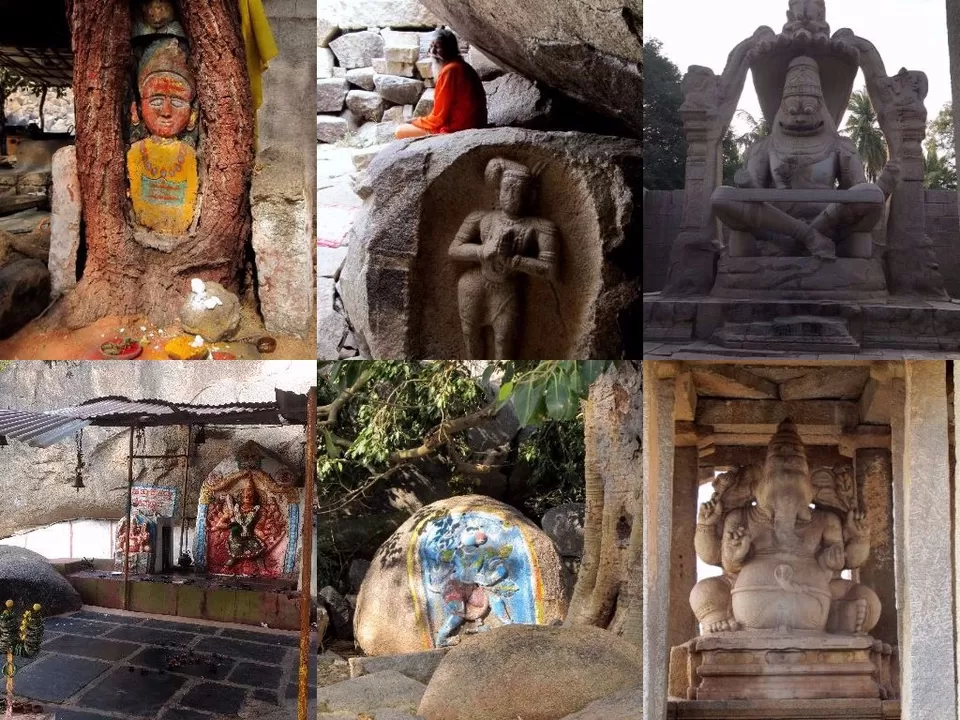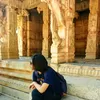Walking through banana groves; slipping on wet rocks; huddling inside a coracle; huffing and puffing the way up hills; laughing hysterically when at the edge of a cliff; warm and ever smiling people; food and some more food….

Some getaways are good; others, unpleasant. Some are a disaster; while some others turn out to be memorable. A journey to the ruins of the Vijayanagara dynasty amidst gargantuan boulders, Hampi, in southern India, is physically exhausting but, at the same time, relaxing and introspective. Be it the 570-step climb to the whitewashed Anjaneyadri, birthplace of the Monkey God, for a sunset; or a thrilling hike to the Matanga hill, that acted as the hermitage of Sage Matanga as also the refuge of Sugriva, to get the best aerial view of the town dotted with its many temples; or a parisal (coracle) ride across the Tungabhadra in the wee hours. Sit back, relax; take it all in, let it sink in. Rugged rocky mountains, lush coconut trees, jigsaw-puzzle-patterned paddy fields, serene water of the mighty Tungabhadra, impish monkeys crossing your path, chillum-puffing sadhus—full of historical and mythological significance, Hampi has all this and more to offer to the travel-weary soul.
The city of Vijayanagara (literally, ‘the city of victory’) was founded in 1336 in the Deccan region by two brothers, Hakka and Bukka, on the banks of the Tungabhadra, a confluence of Tunga and Bhadra rivers. Islamic invasion was looming large: the Delhi Sultanate was expanding its reach. To ward off invasion, two new states were formed—the Bahman Sultanate, based in Gulbarga, northern Karnataka, and the Vijayanagara Empire based at Vijayanagara, central Karnataka, with its capital at Hampi. While the former disintegrated due to internal strife, the latter flourished. However, the year 1565 saw the downfall of the Vijayanagara dynasty at the battle of Talikota: defeat at the hands of the Deccan Sultanate. The short dominance lasting a little over two centuries was marked by the building of a grand city which stands today in a ruinous state, although the ASI has done its best to restore bygone glory and is carrying further excavations to unearth its hidden gems. (For more on the UNESCO World Heritage site, see http://hampi.in/.)

The journey to Hampi is a seven-hour back-breaking, seemingly never-ending journey from the Bangalore airport (it will take another two years for the expansion of the highway to conclude; hopefully the situation will improve then). [Tip: don’t forget to fortify yourself with some French snacks from Café Noir right outside the Departures gate at the Bangalore airport. Quiche Lorraine (ham and bacon and cheese and goodness and sprinkled with a pinch of fresh parsley) and Feuillete au Porc (pork puff) passed the test of this famished glutton. Breakfast for two: ₹1000.] Eventual exhaustion produced only garbled, gurgled sounds from me while reading the signboards, counting the remaining distance to destination: Hiruyur … Hundgud … Hubli … Humnabad … Hosalingpur … Hospet. Of course, monstrous speed bumps, enormous amount of dust, and mammoth trucks never failed to greet at regular intervals! Perpetually hangry, the numerous helpings of tender coconut water (₹30 per coconut) were a sheer respite in the blazing day. We finally reached Uramma Heritage Home, far removed from the bustling city wrapped in almond and coconut trees, late in the evening. Cordial staff, comfortable rooms, fresh home-cooked food, the stay here was pleasurable (beware of the roaches and other creepy crawlies though). The staff was so attentive that when they learnt I am allergic to mustard, they prepared dal without mustard just for me, even though I insisted I could do without it. A special thanks to the staff at UHH for making the stay pleasant.
The following day we took a steamer across the river to the Sacred Centre, the complex that houses the most number of temples. The impressive temples of Krishna, Achyuta Raya, and Vitthala; the only active temple being the Virupaksha Temple. Further ahead lie the Royal Centre with Queen’s Bath, Mahanavami Dibba, Baoli, Hazara Rama Temple, Zenana enclosure, Elephant stables, and the imposing Narasimha Statue.

Then there is the very colourful and ever-buzzing Hampi Bazaar. The next day we woke early, very early, and drove to the river bank, precariously balancing on wet rocks and avoiding the multitude of bathing sadhus, to hop and huddle into our very own coracle. Early morning breeze, the dip of the oar into the cool, dark water at timed intervals, the symphony of chirping birds, and the calm surrounding us awoke our senses fully, and, at 6 a.m. on a Monday morning, we were transported to the years when the city was alive. We let go of our Monday morning blues and forgot our workplaces. Not a word passed our lips, and we rode down the river in silence.

Over the four days of the getaway, our days began early and ended late. Exhausted we would return in the evenings, only to begin early next morning. Naturally, we stole the few nightly hours to sleep like babies! Turns out a spotted cat paid us a visit late one night; we did not have the good fortune (?!) to meet this friend as we battled fatigue and ignored the ruckus created by jumping monkeys on the roof and barking neighbourhood dogs.
On a food trail, Hampi does not have much to offer, yet does not disappoint. At the Mango Tree, with Japanese-style seating (caution: vegetarian restaurant), on the floor, must-try fare include the buttermilk (₹80), shak-shuka, falafel platter, special thali, and buttermilk. [Meal for two: ₹500.] At the Laughing Buddha, there are more cats than our two-legged counterparts. (Be careful where you step, you may land on a furry tail!) Serving international cuisine, the momos here are dry and filled with garam masala(!) and can easily be skipped, while pancakes and pizzas are a must, and so is chicken schnitzel (their version is a deep-fried cutlet) served with fries. [Meal for two: ₹500.] There’s more, what the street vendors have to offer: from local berries and slices of mango sprinkled with chili powder and salt (₹10 per packet), to lassi and more.

Exploring the heritage city on foot was a sheer delight. History comes alive in this forgotten civilization. As one rightly puts, Hampi can be 'a backpacker’s paradise, a pilgrim’s goal, an artist’s muse, a sage’s sanctuary, a poet’s inspiration, a trader’s hub, an adventurer’s dream'. Hampi invites you with open arms and bids farewell with a smiling heart.

_______________________________________
Here’s the itinerary I followed:
Day 1
Drive from the Bangalore airport to Uramma Heritage Home. Reach by 7 pm.
Rest and gear up for the next day. Dinner at UHH.
Day 2
Post breakfast, walk down to the river bed. Take a steamer across the river to start a day-long walk through the ruins of the once magnificent city of Vijayanagara. Begin with the Sacred Centre, the complex that houses the most number of temples. Visit the only active temple in Hampi, Virupaksha Temple. And the impressive temples of Krishna, Achyuta Raya, and Vitthala.
Lunch at the Mango Tree . Then walk through the very colourful Hampi bazaar. Further, climb to view the sunset from Anjaneya temple, birthplace of Hanuman.
Return to UHH by evening. Unwind, have a relaxed dinner, and doze off.
Day 3
Leave at 5 am and reach the river bed. Ride the coracle across the Tungabhadra and proceed to climb the Matanga hill for a beautiful sunrise.
Reach UHH back for a quick breakfast and leave within the next hour to continue the sightseeing. Visit a few more sites.
Then take the motor boat across the river for a relaxed lunch at the Laughing Buddha.
A motor boat will take you back to Hampi Bazaar from we continue on to see the Royal Centre and Narasimha Statue.
Reach UHH by evening. Relax and prepare to leave the next day.
Day 4
Bid farewell and drive back to the Bangalore airport. Reach by the evening and take the flight back home.
Getting there:
Hampi has no direct connectivity of flights or trains. The nearest airport is Hubli (although the Bangalore airport [350 km/7 hours approx. to Hampi] is more accessible from other cities) and the nearest railway station is Hospet. Taxis and buses are available from these places. You can also hop on to a direct overnight bus from Bangalore. Within Hampi, cycles and bikes are available on rent; autorickshaws are also available to take you to the points of interest. However, nothing beats exploring the small town on foot.
Best time:
December to February (max. will still touch 35 degrees Celsius, but not be as HOT as the rest of the year).
Stay:
Apart from the many options on offer, Uramma Heritage Home (http://www.urammaheritagehomes.com/uramma-cultural-residency) is a rustic and comfortable stay far removed from the bustling city. You will be greeted with cordial and attentive staff, comfortable rooms, and fresh simple, home-cooked food.

